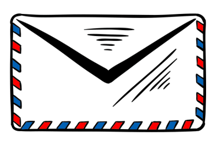
When it comes to marketing your brand, direct mail and email marketing are some of the best ways to get your message directly in front of your target audience. Putting your ad right into their inboxes, either physically or digitally, almost undoubtedly assures that it will be seen.
Let's explore the differences and benefits of these two widely-used marketing strategies and show the potential they can have when they are used together.
What is Direct Mail Advertising?
 Direct mail marketing is one of the oldest and most effective forms of advertising there is. Delivered physically to prospective clients' mailboxes via postal service, it has a high likelihood of engagement because most people check their boxes every day. Flyers, postcards and catalogs need only include your business name, a call to action and contact information. It is totally up to you what else to include. When you enclose a promotional offer with the mailer, consumers are more likely to keep it.
Direct mail marketing is one of the oldest and most effective forms of advertising there is. Delivered physically to prospective clients' mailboxes via postal service, it has a high likelihood of engagement because most people check their boxes every day. Flyers, postcards and catalogs need only include your business name, a call to action and contact information. It is totally up to you what else to include. When you enclose a promotional offer with the mailer, consumers are more likely to keep it.
Meal-kit company, Hello Fresh, does an excellent job of using direct mail advertising. Through green-colored mailings, potential customers are enticed with gifts such as a free box of food if they subscribe to the service. Mailed postcards include a call to visit their website for more information and to sign up.
Direct mail is especially effective at reaching demographics that are less likely to use email or social media, or those who opt-out of email marketing.
What is Email Marketing?
 Email advertising is that which is delivered through electronic mail. An emailed newsletter will include a CTA to visit your website and connect on social media. Data from HubSpot suggests that a staggering 99% of people with email accounts check their inboxes every day, with 59% saying that marketing emails influence their purchasing decisions. A well-crafted email message can have a profound impact on existing customers and lead generation.
Email advertising is that which is delivered through electronic mail. An emailed newsletter will include a CTA to visit your website and connect on social media. Data from HubSpot suggests that a staggering 99% of people with email accounts check their inboxes every day, with 59% saying that marketing emails influence their purchasing decisions. A well-crafted email message can have a profound impact on existing customers and lead generation.
The popular ride-share business, Uber, has one of the simplest yet most effective email campaigns today. Emailed newsletters are brief and to-the-point for users who don't have a lot of time. A link is always included in the email for potential customers to learn more.
The Benefits of Each
Both direct mail and email marketing have numerous benefits.
Direct Mail
Because most people check their physical mail every day and mailboxes are less likely to be flooded with communication than email, your ad is less likely to be overlooked. Customers physically handle mail and are likely to look at it before deciding what to do with it. Even 77% of millennials enjoy receiving mail and pay attention to direct mail advertising.
Because of this, direct mail is a good opportunity to send a promotional offer. Don't forget to include a CTA to visit your location or website.
Email marketing is one of the most cost-effective forms of advertising there is. It has tons of creative possibilities, and it’s interactive. With email, you can directly drive your customers to your website and social media pages, and it makes it easy to get last-minute or time-sensitive information to the customer quickly. Creative can also be swapped out and deployed faster than direct mail.
Sending ads via email versus direct mail is also very cost effective and offers an excellent ROI. Email marketing is purchased via a CPM (cost per thousand) price point, so you can send to a large group of potential customers without having to worry about printing and postage expenses. ROI is 3,800%, and it’s easy to track.
Emails can be personalized and are less likely to get lost or crammed in with other flyers and mail. This makes it highly probable that your target audience will see your marketing versus going straight into the recycling bin.
Including video is another great advantage to email. This can engage your recipients and showcase your products. There are also fun interactive tools you can integrate into your message like choose your favorite color of your brand new car or put together a new outfit. All the clicks and views are track-able, plus will push your consumers closer to that purchase button.
With the significant rise in e-commerce during 2020, email marketing has also seen a huge spike. Your personalized email can take customers directly to your online store and easily add items to their cart. Adding a special online discount code is always a nice touch too.
At the height of the global pandemic, email marketing was a significant driving force behind e-commerce. There was a 31% lift in year-over-year open rates, boosting traffic to e-commerce sites by nearly 12%. Businesses should look to expand their opt-in marketing channels, as email continues to be a trusted resource for consumers.
How These Marketing Strategies Can Successfully Work Together
 When you use direct mail and email marketing, you raise the likelihood of engagement with your brand. In situations where direct mailings are forgotten or accidentally thrown out, an email serves as a reminder of your communication. Make sure all your correspondence is consistent, eye-catching and includes a CTA.
When you use direct mail and email marketing, you raise the likelihood of engagement with your brand. In situations where direct mailings are forgotten or accidentally thrown out, an email serves as a reminder of your communication. Make sure all your correspondence is consistent, eye-catching and includes a CTA.
Campaigns that combine direct mail marketing with email marketing enjoy a higher response rate. You might use direct mail to send out attractive flyers about a sale you are hosting. On the heels of that mailing, an email reminding your audience about the sale could also include an incentive for attending, like an additional 10% off purchases. The response rate can give you a database of engaged customers who are more likely to be responsive to future marketing.
Your Media Partner Can Help
To get your marketing campaigns off the ground, consult your media partner. When you combine both forms of marketing, you are increasing the likelihood of engagement and potential ROI.
![grayLasVegasLogo11-18-21[1] grayLasVegasLogo11-18-21[1]](https://www.graylasvegas.com/hs-fs/hubfs/grayLasVegasLogo11-18-21%5B1%5D.png?width=7128&name=grayLasVegasLogo11-18-21%5B1%5D.png)




